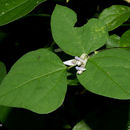en
names in breadcrumbs


Amphicarpaea bracteata (hog-peanut or ground bean) is an annual to perennial vine in the legume family, native to woodland, thickets, and moist slopes in eastern North America.[2]
Leaves have three leaflets and are held alternately on twining stems.
Flowers are pink to white and bloom from late summer to autumn. The flowers are either open for cross-pollination or closed and self-pollinating. The closed flowers may be above or below ground.[3]
Seeds from open flowers are held in a flat pod, pointed at both ends, that dries when mature and twists to release the seeds. Seeds from closed flowers are held in round pods with a single seed each. The roots and the cooked seeds from under the ground are edible.[4][5] The seeds which become subterranean from flowers on stolons give it the name peanut.[6]
This plant can be found in eastern North America, as well as further west into the Midwestern region, including Indiana,[6] Illinois,[6] and Wisconsin.[7]
Amphicarpaea bracteata (hog-peanut or ground bean) is an annual to perennial vine in the legume family, native to woodland, thickets, and moist slopes in eastern North America.